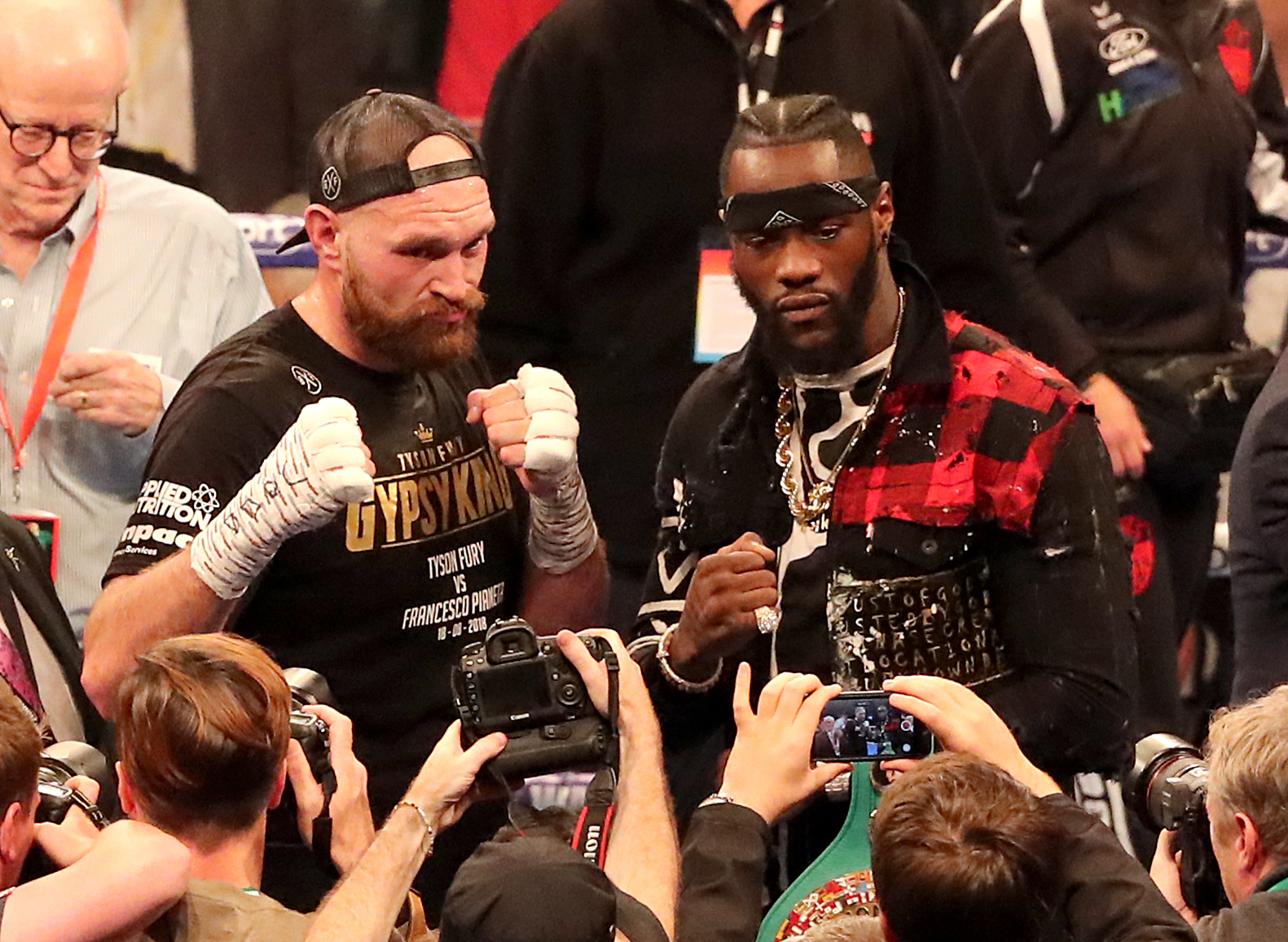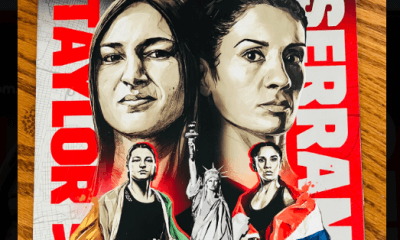Featured Articles
The Avila Perspective Chap. 22, Rare Heavyweight Rumble in L.A. and More

Southern California has long been a bastion for prizefighting since the beginning of the modern boxing era in the 1880s.
Yet, very few heavyweight world title fights have taken place in Los Angeles or the surrounding areas. Though the state of California stages more prizefights than any other place in the world, it’s been over four years since the big guys fought for a world title in the city of Angels. Less than a dozen heavyweight world title fights have ever taken place in greater Los Angeles.
WBC heavyweight titlist Deontay Wilder (40-0, 39 KOs) looks to snap that streak when he fights Tyson Fury (27-0, 17 KOs) at the Staples Center in the heart of downtown Los Angeles on Saturday Dec. 1. Showtime pay-per-view will televise.
“Heavyweight boxing is so exciting at this point in time; it’s on fire and I’m just so excited to be a part of the movement and I’m proud to be a part of this heavyweight division and be at the top of the podium as one of the kings of the division,” said Wilder.
It’s always amazing to see two large heavyweights exchanging blows in a boxing ring. Especially two gargantuan sized fellows with wingspans the size of a small Cessna. The boxing ring looks tiny when they’re inside.
Nothing seems to bring out the glitterati more than a heavyweight world title fight. I’ve seen more movie stars and entertainment celebrities at a heavyweight championship fight than at a baseball World Series game. The only thing that comes close would be an NBA championship game but that was long ago when Kobe Bryant sprinted on the courts for the Los Angeles Lakers.
Come to think of it, maybe it’s due to their triple X size.
The last heavyweight title fight in Los Angeles took place in May 2014 when Bermane Stiverne stopped Chris Arreola in the sixth round at the Galen Center across the street from USC. The late great Dan Goossen promoted that fight. A few months later the popular promoter would pass away from cancer. God rest his soul.
Goossen always wanted a heavyweight champion. We spoke many times on the subject of heavyweights. Even his son Craig Goossen would mention their dream of having a heavyweight world champion. It’s something he wanted for his dad. That goal was never reached sad to say.
Heavyweight fog
Back in the 70s the axiom was if you had the heavyweight world champion you controlled boxing. It changed when the IBF formed in 1984 with Larry Holmes its first champion and later the WBO formed and developed their own champions too. It confused fans and muddled the heavyweight landscape with too many champions.
Mike Tyson temporarily fixed that by annihilating everyone who dared claim to be a heavyweight world champion in the late 1980s. Through brutal methods he unified the heavyweight world championship and later it was passed to Evander Holyfield, then Lennox Lewis who added the IBO title to the ensemble in 1999.
The advent of the 21st century brought heavyweight disarray. But one thing that kept everything in order was the realization that if you checked the lineage of the heavyweight championship from fighter to fighter you could get trace the actual champion. It was something that boxing writers brought to the sport and it’s a primary reason journalists are important to prizefighting. The Ring magazine had a lot to do with connecting the dots of the actual passing of the heavyweight title from man to man.
That’s how we arrived to the fact that England’s Tyson Fury is a descendant of the first heavyweight world champion of the modern boxing era John L. Sullivan. Fury is the lineal holder of the title and Wilder has one of the more credible titles in the WBC belt. The winner can truly be called the heavyweight world champion of the world or as Mike Tyson once said “the baddest man on the planet.”
When Fury and Wilder meet it definitely clears up the heavyweight situation and determines the actual and true world champion. Apologies to Anthony Joshua.
“I’m the baddest man on the planet,” said Wilder recently, echoing Mike Tyson’s claim of long ago.
Looking back
Despite the rarity of heavyweight world title fights in Los Angeles there have been a few of significance.
Nobody living saw the first heavyweight world title fight in Los Angeles back on February 1906 when Tommy Burns beat Marvin Hart by decision after 20 rounds. Burns then defeated Fireman Jim Flynn on October 1906 and drew against Philadelphia Jack O’Brien on November 1906 and then defeated O’Brien in May 1907. All of those heavyweight defenses took place in Los Angeles.
The world did not see another heavyweight world title fight until 1939 when Joe Louis knocked out Jack Roper in the first round at Wrigley Field in South Los Angeles and did not see another for nearly 20 years until Floyd Patterson defended against Roy Harris at the same Wrigley Field in L.A. in 1958.
Heavyweights just didn’t make a habit of fighting in Los Angeles.
In 1973, Muhammad Ali fought Ken Norton in a rematch at the Inglewood Forum and won the rematch by split decision. He had lost the first encounter six months earlier in San Diego. Ironically, both Ali and Norton would live in Los Angeles through the 1990s and had offices within a half mile of each other in the Wilshire District.
In 1967, Joe Frazier fought Scrap Iron Johnson in a nontitle bout at the Olympic Auditorium which is about a half mile from the Staples Center. Fans who saw that fight claim it was the only time Frazier ever danced in a fight. Scrap Iron didn’t have a reverse gear, he was like a human glacier that only moved forward.
Jerry Quarry was the only real heavyweight that Los Angeles fans ever truly knew. But once he hit the contender status he rarely fought in Southern California. The big money was in Madison Square Garden. After fighting as a main event in the Olympic Auditorium from 1965 to 1967 against the likes of Joey Orbillo and Floyd Patterson, he grew too big for the limited seating of the Olympic Auditorium. His last L.A. appearance took place at the Inglewood Forum against Tony Doyle in 1973. That was after fighting Muhammad Ali twice in mega fights in Atlanta and Las Vegas. Quarry was too big an attraction and met the biggest names at the time in Earnie Shavers, Joe Frazier, and Ken Norton at Madison Square Garden.
Though Mike “Hercules” Weaver made his pro debut at the Olympic Auditorium in September 1972 it would be years before he found himself. After a 50/50 record during his first 11 pro fights, Weaver then found his groove outside of Los Angeles and made himself into a heavyweight contender. In June 1979 he fought Larry Holmes in a thrilling battle at Madison Square Garden. The next year Weaver would win the WBA heavyweight world title by knockout over John Tate. He fought Stan Ward at the Inglewood Forum in 1983 but no longer held the title. Both Weaver and Ward still live in Southern California and train fighters.
Vitali
No Southern California heavyweight was deemed worthy of challenging for a world title in Los Angeles until the arrival of Vitali Klitschko. The Ukrainian native was training in Los Angeles and fought three heavyweight world title fights in the city of Angels.
The first encounter was the best.
When Klitschko challenged Lennox Lewis at the Staples Center, in June 2003, he drew enthusiastic crowds from various geographic and social settings that stretched from the ritzy Malibu Beach crowd to the cruising sets of East L.A. Ontario and beyond. All were anxious to witness a rare heavyweight world title showdown.
They were not disappointed.
Southern California fans are accustomed to watching world title fights, but usually it’s at the lower weight classes.
When United Kingdom’s Lewis defended the WBC title against Klitschko 15 years ago it was strange for L.A. boxing fans to see two gargantuan men exchange concussive blows in a boxing ring.
That heavyweight clash still remains one of the best heavyweight collisions ever staged in Southern California. Both let loose when massive blows and showed incredible determination in a clash that saw blood pouring out of Klitschko’s eye forcing the fight to be stopped prematurely. Fans fell in love with Klitschko for his grit and with Lewis for his willingness to trade bombs with the big Ukrainian. It would turn out to be the last fight for Lewis who then retired from the sport.
Klitschko would later win the heavyweight world title and fight twice more in Los Angeles. First against Corrie Sanders in April 2004 and then against Southern California’s Chris Arreola in September 2009. It was the third and final time Klitschko would fight in Los Angeles. After that he only fought in Europe and when his brother Wladimir Klitschko won the other versions of the heavyweight titles that closed the door to America as both Klitschkos opted to fight in Europe.
Southern California has not seen a heavyweight world title fight since Stiverne-Arreola in 2014. And in the history of prizefighting in the Los Angeles area only 11 heavyweight world title fights have ever taken place.
It’s history indeed when American heavyweight Wilder defends the WBC title against lineal champion Fury of Great Britain. It is well worth watching.
More importantly, the winner between Wilder and Fury has a true claim on the lineal heavyweight world title that can be traced all the way back to the first heavyweight world champion of the modern era John L. Sullivan.
“I’m the lineal champion of the world,” said Fury of holding the distinction. “I’ve never been beaten.”
Tickets are still available for the Staples Center in Los Angeles.
Check out more boxing news on video at The Boxing Channel
-

 Featured Articles4 weeks ago
Featured Articles4 weeks agoAvila Perspective, Chap. 330: Matchroom in New York plus the Latest on Canelo-Crawford
-

 Featured Articles3 weeks ago
Featured Articles3 weeks agoVito Mielnicki Jr Whitewashes Kamil Gardzielik Before the Home Folks in Newark
-

 Featured Articles8 hours ago
Featured Articles8 hours agoResults and Recaps from New York Where Taylor Edged Serrano Once Again
-

 Featured Articles4 weeks ago
Featured Articles4 weeks agoCatching Up with Clay Moyle Who Talks About His Massive Collection of Boxing Books
-

 Featured Articles5 days ago
Featured Articles5 days agoFrom a Sympathetic Figure to a Pariah: The Travails of Julio Cesar Chavez Jr
-

 Featured Articles3 weeks ago
Featured Articles3 weeks agoMore Medals for Hawaii’s Patricio Family at the USA Boxing Summer Festival
-

 Featured Articles7 days ago
Featured Articles7 days agoCatterall vs Eubank Ends Prematurely; Catterall Wins a Technical Decision
-

 Featured Articles4 weeks ago
Featured Articles4 weeks agoRichardson Hitchins Batters and Stops George Kambosos at Madison Square Garden




















